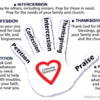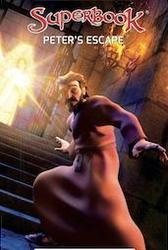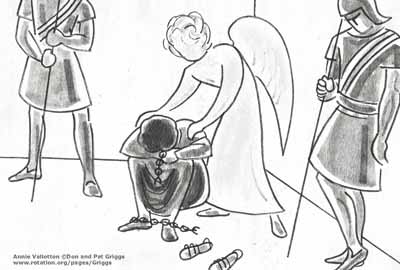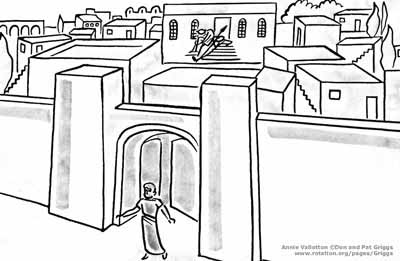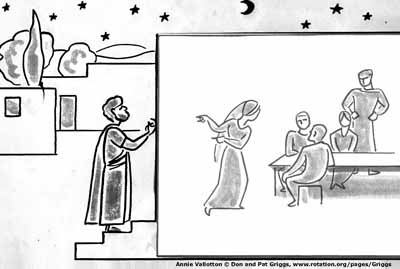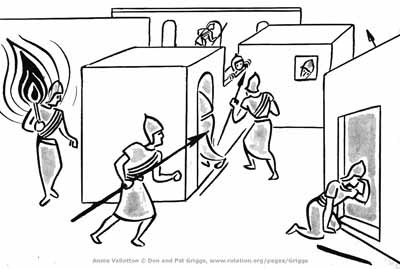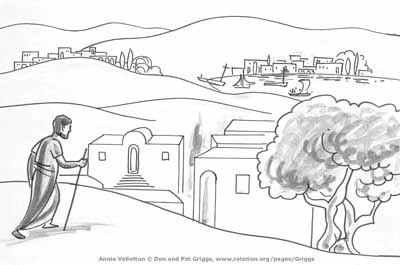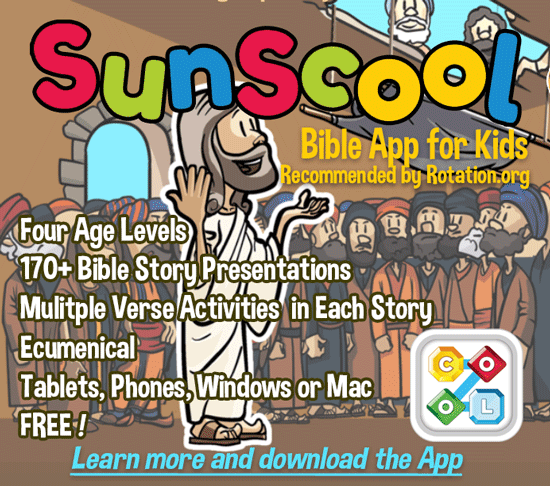This topic is collecting lesson ideas and resources for the story of Peter escaping prison in Acts 12.
Acts 12 tells the story of Peter being arrested in Jerusalem and thrown in prison by King Herod (Antipas), only to be rescued by the angel.
If you're looking for the story of Paul and Silas in the Phillip jail ~ earthquake and jailer story, go to our Acts 16 forum ![]()
Let's get this topic started with these three lessons from our friends at State St UMC in Virginia! ![]()
Peter Escapes from Prison, Acts 12
Suddenly an angel of the Lord appeared and a light shone in the cell. He struck Peter on the side and woke him up. “Quick, get up!” he said, and the chains fell off Peter’s wrists.
Summary of Jaymie's four Acts 12 lesson resources:
- Bible Background on Peter in Acts 12 (scroll down in this post)
- Drama Workshop: Children will act out the story. "Still photographs" will be taken and printed out to create a photo storybook.
- Prayer Workshop: Children will learn about the different types of prayer, then go on an "Intercessory Prayer Walk" around the church.
- Video Idea: We added a video suggestion: "Paul & Silas" (Superbook Series). See post for video summary.
A Bible Background with Discussion Questions/Life Application
What's in a Name?
When Peter first appears in the gospels, his name is Simon bar Jonah (Simon, son of Jonah). Jesus changes Simon's name to Cephas (Aramaic) or Petros (Peter - Greek). Jona means dove, while Cephas and Peter mean rock. Jesus is essentially saying to Peter, "Once you were just a flitting, fluttering dove. If you will trust me as your Lord, I will make you into a rock." As we have seen in our last two rotations (Peter's Denial and Peter's Restoration), Peter has not always acted "rock-like." Peter's name change is a reflection of who he would become, not who he already was. Each of us has a "next step" in our discipleship. As with Peter, God sees our potential and yearns for us to fulfill it.
 What name would you like to be known by that would reflect your hopes and dreams and faith?
What name would you like to be known by that would reflect your hopes and dreams and faith?
Who is Peter?
We know a great deal about Peter the disciple from Mark and Luke, two early converts. The Gospel of Mark and Luke feature Peter as Jesus' most important disciple, and Luke's Book of Acts features Peter until Paul's conversion,
Peter was a man of action, with a quick temper and impulsive nature, typical of Galileans so it was said. To Peter's credit, he does not hold back even though he makes mistakes or puts himself in harm's way. Peter wants everyone to experience, as he has, the forgiveness and grace of Jesus and the transforming power of the Holy Spirit. And as with all of us, God can use what's strong or weak about us for Godly purposes!
Peter was a fisherman, in partnership with James and John. He was married and lived in Capernaum in Galilee. As one of the first disciples to be called by Jesus, Peter quickly became a leader during Jesus' lifetime, and in the days of the early church.
Acts 12 represents the "zenith" of Peter's story. His story will soon be eclipsed by Paul who is introduced in Acts 9 and 11. While Peter still maintains a position of authority in Jerusalem and will be instrumental in welcoming and approving of Paul's teaching and mission, Peter is older now and a new generation of Christians is rising. They include Paul, Barnabas, Silas, Lydia, and many others across the Greek world.
 How would people describe your strengths and weaknesses?
How would people describe your strengths and weaknesses?
 Who is leading you/your church now that are hoping you will be the next great disciples and leaders?
Who is leading you/your church now that are hoping you will be the next great disciples and leaders?
Peter's Arrest on Pentecost
The Jewish Feast Day of Unleavened Bread is essentially a springtime early harvest festival that takes place 50 days after Passover. Known as Pentecost ("50"), this festival featured the arrival in Jerusalem of many pilgrims from different regions, which meant it could also be a flashpoint for unrest and rebellion. King Herod Antipas, the same one whom Jesus had been tried before, was charged with keeping the peace or face further oppression by the Roman army. Peter was thus likely "swept up" with other potential troublemakers. He put James the brother of John to the sword (Acts 12:2) and threw Peter in jail -- most likely to await his own EXECUTION.
 How is the message of Christ "trouble" for those powers who wish to oppress others?
How is the message of Christ "trouble" for those powers who wish to oppress others?
Peter Escape Prison with Heavenly Help and Prayer
Acts 12:5 makes a point to say that the church was praying for a miracle when Peter was thrown in prison. Early Christians believed they could move God to act through prayer. Today, we might say that prayers is God moving us to action!
And sure enough, it happened. An angel appeared, Peter's chains dropped off, guards fell alseep, a door miraculously opens by itself, and Peter escaped and hid at Mary's house, the mother of John-Mark. Soon thereafter, Herod died "eaten by worms." Peter's story then recedes into the background of Acts, reappearing briefly chapter 15 to approve of Paul's ministry, and then he disappears from Acts (there is no mention of him going to Rome in the Bible, that is only a tradition).
 Who are the "angels" in your life keeping you safe, and helping you when you are trouble? How can YOU be an angel to someone in trouble?
Who are the "angels" in your life keeping you safe, and helping you when you are trouble? How can YOU be an angel to someone in trouble?
Why then was Peter saved from prison only to diminish in importance (according to Acts)? Many Christians die without ever being rescued from their fate, and James the Brother of Jesus was already a key leader in the early Church. Could it be that "God was not done with him yet?" God needed Peter to do one more great task -- approve and support Paul's mission to the Gentiles. Without it, Paul may have been rejected.
God usually moves silently through the world he created, and sometimes, like Peter said, his presence and power moving through us "feels like a dream" (v9). And like Peter, we don't always understand God's plans, but we pray to become part of his story, his creation, his plans. We pray that God would break the chains that hold back our faith and our desire to serve him. That God would replace fear with trust -- trust that we are part of a greater plan.
 Imagine what great task might God have in store for your life some day. Who does God see that needs you to be their friend, to help them serve others?
Imagine what great task might God have in store for your life some day. Who does God see that needs you to be their friend, to help them serve others?
 What chains are holding you back that we should pray "be broken!"
What chains are holding you back that we should pray "be broken!"
A Bible Background by members Jaymie and Neil MacQueen

 Place a canvas painter's tarp on the floor in the corner of a classroom. Lay some folding tables on their side to form low walls (to give the feeling of an enclosure). You may also use paper painter's dropcloths tacked to the walls or covering the tables.
Place a canvas painter's tarp on the floor in the corner of a classroom. Lay some folding tables on their side to form low walls (to give the feeling of an enclosure). You may also use paper painter's dropcloths tacked to the walls or covering the tables. As children arrive, have them choose a slip of paper for their role in the skit. Next, have them select costumes and props and go "sit in prison." Have a "jailer" in the prison loosely wrapping chains around their wrists. (Use lamp swag chain or loops of twine you've prepared. This will get them in the mood and anticipating your lesson!)
As children arrive, have them choose a slip of paper for their role in the skit. Next, have them select costumes and props and go "sit in prison." Have a "jailer" in the prison loosely wrapping chains around their wrists. (Use lamp swag chain or loops of twine you've prepared. This will get them in the mood and anticipating your lesson!)


 As you say the following, gently WRAP the student's arms/chest/head with rope or decorative lamp chain to symbolize being locked up -- kind of like Peter was in the story.
As you say the following, gently WRAP the student's arms/chest/head with rope or decorative lamp chain to symbolize being locked up -- kind of like Peter was in the story. in the palm of their hand drawing and label it "Listening."
in the palm of their hand drawing and label it "Listening."